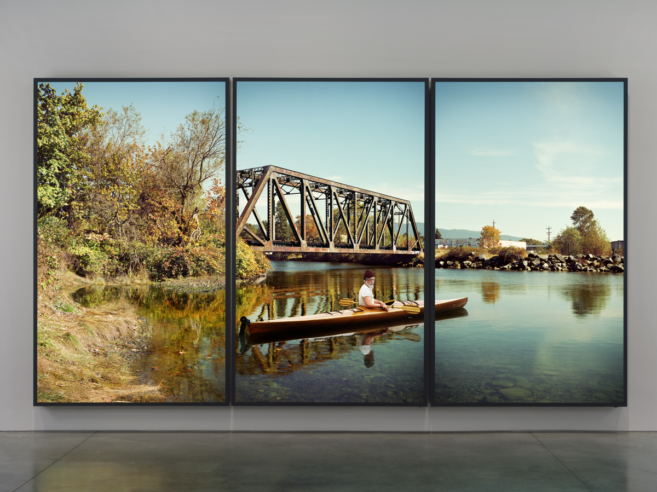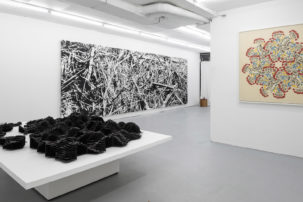Founded in 1997 by curator and writer Patrik Andersson, Trapp Projects ignores classic distinctions within art organizing, manoeuvring between publications, institutional exhibitions and experimental projects. Since its beginnings, Trapp Projects has been inspired by Romanian-Swiss artist Daniel Spoerri’s Tableau Piège or Snare-pictures, a series of random compositions—remnants left after a meal, for example—photographed in their found arrangement. It is also from Spoerri’s book An Anecdoted Topography of Chance (1962), which explores the psychogeography of daily life, that Trapp Project’s latest group exhibition, “Leftovers: Topographies of Chance,” draws its name. Like the artist book, the exhibition—which filled part of the former Catriona Jeffries Gallery space, where Trapp Projects will take up residence over the next year—offered a collection of works that also experiment in mapping what has been left behind, through memory, history, philosophy and playful anecdotes—all in reference to the often-overlooked and dismissed realities of the everyday.
A display of dishware from the last project by N.E. Thing Co. (NETCo), Eye Scream Restaurant/Gallery Dishes (1977), was neatly stacked in a vitrine in the centre of the gallery. Across the room was a photograph by Hannah Dubois, granddaughter of NETCO co-founders Iain and Ingrid Baxter. Dubois’s Recurring View (1968/2002/2012/2019) observes the psychogeography of chance, and the photograph, like Dubois, has an intriguing lineage. Through a Google search, Dubois discovered a NETCo piece (Start Viewing, Deep Cove, BC) photographed in her neighbourhood. The original image from 1968 features a man—assumed to be Dubois’s grandfather, Iain Baxter—holding a sign that obscures his face with the words “START VIEWING.” Dubois created Recurring View by rephotographing the location in the photo and superimposing it on top of the original image. The work acts as a reminder of the complexities of NETCo’s dissolve in 1978, questions of authorship and the slipperiness of creation dates, which become elusive when artworks are reproduced or repurposed.
Steven Brekelmans’s One Man Band (Tabletop Variation) (2017–19), features an eclectic collection of items removed from the shelves of his studio and set atop a Ping-Pong table sourced by the artist from the community-based buy-and-sell website Craigslist. Brekelmans’s object map includes projects in progress, in a state of transition, and fragments of works from past exhibitions, still shifting and moving. The connections between these objects remain unfixed; they are for the viewer’s imagination to map together.
Referentially framing the exhibition in three corners were Kurdish rugs rolled and wrapped in copper wire, which make up Parvin Peivandi’s Standing on the three corners of the art gallery with sore feet: A security guard, an immigrant woman, and a left out artist (2019). The carpets immediately recall security guards, so ubiquitous within institutions. With positions often filled held by immigrants and art students, security guards are the quiet and attentive custodians of artworks—the human pillars that watch us within institutions.
This exhibition maps what is left behind conceptually within the artworks, and also creates an added topological depiction within Vancouver’s art ecology for new chance encounters. It is a reactivation of space and material, much like Jean MacRae’s contribution to the show, Shrinking (Study for The North West Passage) (2019), which reworks maps of the Northwest Passage after UBC’s Geography department digitized and deaccessioned its records. MacRae physically crumpled the archival map paper, texturizing these documents and ultimately reshaping them—much like the changing landscapes that the maps depict.
There is something earnest and refreshing about the Trapp Projects temporary commercial project space in a scene otherwise dominated by artist-run centres and public institutions. With its hybrid approach (most work is for sale, yet it’s not technically a commercial gallery), Trapp affords a platform to artists who might not otherwise have access to this degree of exposure and gallery representation while also collaborating with commercial spaces whose artists are included in the exhibition. Like Spoerri’s Snare-pictures that captures a bird’s-eye view of tables after a meal, this exhibition is itself an exploration of pieces and spaces leftover. Similar to the ball of dust Cameron Kerr collected in Venice in 2017 and positioned in a vitrine within the exhibition, Andersson found his own chance encounters to map out a new kind of space in the city.







